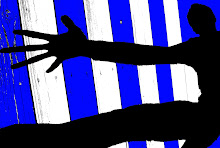- placing a microphone in a couple locations throughout my apartment and having it turn on a different times throughout the week and record the activity. At the end of the week create a compilation of what has occurred in that space through incorporation with music.
- varying the frame rate of a slideshow like projection to get merging images
- building filters for my camera and attempting to shot things that fit the filters. For example building a lens cover that has a word cut out of it and then shooting something that portrays this word so that you get only portions of the image that fall in the cut-out letters. This could be done with figures as well.
____________________________________________________________________
Response From Class 1/15/08
Yannis Ritsos - Erotica XII
I feel that the use of the present tense in this piece allows you to visualize what is going on much easier. With the present tense you can see the actions that are tacking place as they are happening. With the past tense you don't have such an opportunity, it is much more natural to hear and feel what is actually going on in the following section of the poem:
A hoop from a barrel of olden times rolls down the hill,
falls into the stream, tossing off drops that wet your feet,
and also wet your chin. Stop that I may wipe you.
The use of present tense puts you right in the action, right where it is taking place. You can see the hoop rolling and throwing drops of water; you can feel them on your feet.
Ernst Jandi - Preliminary Studies for the Frankfurt Readings 1984
The following are a couple links that show videos that explore the mouth as a servant. These are extreme cases in which people have harnessed the control of the mouth to a level many are not capable of.
This guy can speak the words in sentences completely backwards:
The fastest speaking person in the world (go to minute 1:00 of the video):
The fastest drinker:
Octavio Paz - Blanco
I think that the structure of this passage allows for some personal interpretation on how it should be read. This is especially present in the sections of the piece that are composed of two components side-by-side, each containing different fonts. One of them is bold, the other is italicized. Should you read the bold component first, then read the italicized component, or should you read one line of the bold, then the corresponding line in the italicized. I read the passage once each way. Even though on first glance it may seam unnatural to read one bold line followed by one italicized line (because they appear to have been intentionally separated), I actually like to see the similarities and differences between each individual line. Reading directly across the page helped identify these.

1 comment:
Fine, fine project frame systems! --any and/or all.
Present tense does seem to contribute active tracking of the progression, and that active tracking could enhance the observer's involvement, even perhaps transforming the observing into a participant, however peripheral that participation might be (at first).
What I find so useful in your Paz comments is the apparent necessity of choice, an ability to engage with the parts presented because of the nature of the presentation, a more complicated presentation of sequence
that also comments on expectation.
The reading you describe is also a journey through frame systems, flexible frame systems. This also exercises the frames, and the perceptual monitors of the shifts in interpretation strategies that the shifts enable. Practice in temporary locking, temporary unlocking;
an emphasized reminder that locking/unlocking can be temporary.
Post a Comment